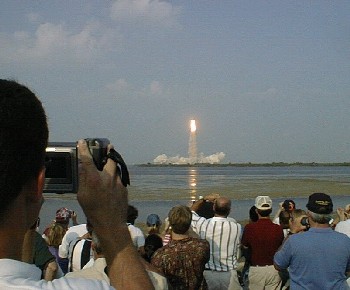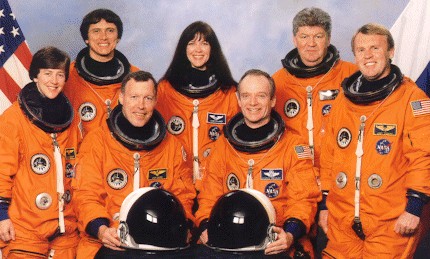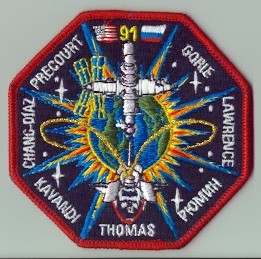Lift-Off
Today, we all count 3-2-1. The University of Houston's College of Engineering presents this series about the machines that make our civilization run, and the people whose ingenuity created them.
May 30th, 1998. We land in Orlando. On the car-rental bus we meet a man who, like us, has come to see the rocket launch. His company built the external liquid-fuel tank that'll lift Discovery into orbit. It's made of a new aluminum, and it weighs four tons less than older tanks. My wife and I glance at each other as the shadow of the external tank exploding under Challenger passes between us. A new technology is making its first flight!
We stop for supper at a Cocoa Beach restaurant. Photos of astronauts deck its walls. The waitress says she sees every launch. She watched Challenger. She recites technical particulars. History is being made here, and she understands that she's part of it.
Sunday afternoon: We tour the Kennedy Space Center. We're like country mice in the city. Here's the old Saturn V rocket, longer than a football field, with the explosive capacity of an atom bomb.
Monday noon: the wife of a Discovery crew member hosts a picnic. We all come to express our good wishes. The gathering is quiet and supportive. The astronaut's daughter and her friend take turns holding a puppy while his wife moves from one group of friends to another. At length I shake her hand and tell her I look forward to a flawless flight. "So do I," she replies flatly.
Tuesday: two hours left in the countdown. Hundreds of us mill about under that Saturn Rocket. A score of astronauts mix with the crowd -- shaking hands, signing autographs, putting us at ease. No one doubts that they're special people. These few represent a vast community that's made this flight possible. And they've been chosen well. I ask one, "What're the last three hours like, closed in the shuttle, waiting?" "You clear your mind and rehearse your tasks," he says. "Your training's done. It's out of your hands."
Liftoff minus minutes: We all focus on the pad. No carnival atmosphere. The astronauts are out there alone -- no human within three miles, and our task is to will them into the sky. Three, two, one. Clouds of vapor roll silently away from the pad. Then orange flame. The rocket is a tiny focal point on a column of fire. Sixteen seconds pass, and a cosmic roll of thunder reaches us.
The crowd's initial cry of relief falls quiet. We wait for the solid boosters (the ones with the famous O-rings) to detach. The flame abruptly widens and we make out two fading side tendrils. The boosters are away, and that new external tank now hurls six brave men and women toward rendezvous with the Mir Space Station.
We move quietly back to our buses. Twenty-third century historians will recall more about these events than they will about kings and battles. And we're all out there riding the rocket: engineers, teachers, waitresses, managers, theoreticians and machinists. We savor our many roles in shaping the future. It makes sense for NASA to include us all in these launches. These are, after all, the first tentative steps of our species away from Cradle Earth.
I'm John Lienhard, at the University of Houston, where we're interested in the way inventive minds work.
(Theme music)
The launch of the Discovery Shuttle Flight STS-91 did go off flawlessly, just after 6:00 PM, Tuesday, June 2, 1998. The crew included astronauts Charles J. Precourt (commander), Dominic L. Pudwill Gorie (pilot), Franklin R. Chang-Diaz (payload commander), Wendy B. Lawrence (mission specialist), Janet L. Kavandi (mission specialist), and cosmonaut Valery V. Ryumin (mission specialist).
On Thursday, June 4th, Discovery docked with Mir, where it added one more member to its crew. Astronaut Andrew Thomas had spent over four months doing biomedical experiments on Mir (see Episodes 1306 and 1312.) At this writing we expect him to return to Earth on Friday, June 12th.

Discovery flight STS-91 begins
Photo by John Lienhard

Official NASA photo of the STS-91 crew. From left to right:
Lawrence, Chang-Diaz, Gorie, Kavandi, Precourt, Ryumin, Thomas

NASA's official STS-91 patch